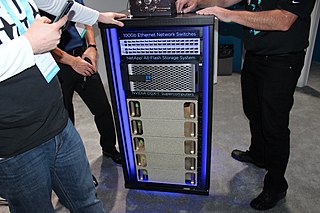
Advanced Micro Devices, Inc., commonly abbreviated as AMD, is an American multinational semiconductor company based in Santa Clara, California, that develops computer processors and related technologies for business and consumer markets.

x86-64 is a 64-bit version of the x86 instruction set, first released in 1999. It introduced two new modes of operation, 64-bit mode and compatibility mode, along with a new 4-level paging mode.
As of 2020, the x86 architecture is used in most high end compute-intensive computers, including cloud computing, servers, workstations, and many less powerful computers, including personal computer desktops and laptops. The ARM architecture is used in most other product categories, especially high-volume battery powered mobile devices such as smartphones and tablet computers.

A multi-core processor is a microprocessor on a single integrated circuit with two or more separate processing units, called cores, each of which reads and executes program instructions. The instructions are ordinary CPU instructions but the single processor can run instructions on separate cores at the same time, increasing overall speed for programs that support multithreading or other parallel computing techniques. Manufacturers typically integrate the cores onto a single integrated circuit die or onto multiple dies in a single chip package. The microprocessors currently used in almost all personal computers are multi-core.
The transistor count is the number of transistors in an electronic device. It is the most common measure of integrated circuit complexity. The rate at which MOS transistor counts have increased generally follows Moore's law, which observed that the transistor count doubles approximately every two years. However, being directly proportional to the area of a chip, transistor count does not represent how advanced the corresponding manufacturing technology is: a better indication of this is the transistor density.
Intel oneAPI DPC++/C++ Compiler and Intel C++ Compiler Classic are Intel’s C, C++, SYCL, and Data Parallel C++ (DPC++) compilers for Intel processor-based systems, available for Windows, Linux, and macOS operating systems.
Datain use is an information technology term referring to active data which is stored in a non-persistent digital state typically in computer random-access memory (RAM), CPU caches, or CPU registers.

Renée J. James is an American technology executive, who was formerly the president of Intel. She founded Ampere Computing in October 2017, is currently its Chairman and CEO. She is also an Operating Executive with The Carlyle Group in its Media and Technology practice. James also serves on the National Security Telecommunications Advisory Committee, which she formerly chaired. The NSTAC advises the President of the United States. James also serves as an independent director of Citigroup.

Zen is the codename for the first iteration in a family of computer processor microarchitectures of the same name from AMD. It was first used with their Ryzen series of CPUs in February 2017. The first Zen-based preview system was demonstrated at E3 2016, and first substantially detailed at an event hosted a block away from the Intel Developer Forum 2016. The first Zen-based CPUs, codenamed "Summit Ridge", reached the market in early March 2017, Zen-derived Epyc server processors launched in June 2017 and Zen-based APUs arrived in November 2017.

Nvidia DGX is a line of Nvidia-produced servers and workstations which specialize in using GPGPU to accelerate deep learning applications. The typical design of a DGX system is based upon a rackmount chassis with motherboard that carries high performance x86 server CPUs. The main component of a DGX system is a set of 4 to 16 Nvidia Tesla GPU modules on an independent system board. DGX systems have large heatsinks and powerful fans to adequately cool thousands of watts of thermal output. The GPU modules are typically integrated into the system using a version of the SXM socket or by a PCIe x16 slot.

Epyc is a brand of multi-core x86-64 microprocessors designed and sold by AMD, based on the company's Zen microarchitecture. Introduced in June 2017, they are specifically targeted for the server and embedded system markets. Epyc processors share the same microarchitecture as their regular desktop-grade counterparts, but have enterprise-grade features such as higher core counts, more PCI Express lanes, support for larger amounts of RAM, and larger cache memory. They also support multi-chip and dual-socket system configurations by using the Infinity Fabric interconnect.
Transient execution CPU vulnerabilities are vulnerabilities in a computer system in which a speculative execution optimization implemented in a microprocessor is exploited to leak secret data to an unauthorized party. The archetype is Spectre, and transient execution attacks like Spectre belong to the cache-attack category, one of several categories of side-channel attacks. Since January 2018 many different cache-attack vulnerabilities have been identified.

Zen 4 is the codename for a CPU microarchitecture designed by AMD, released on September 27, 2022. It is the successor to Zen 3 and uses TSMC's N5 process for CCDs. Zen 4 powers Ryzen 7000 mainstream desktop processors and is used in high-end mobile processors, thin & light mobile processors, as well as EPYC 9004 server processors.
Zen 5 is the codename for an upcoming CPU microarchitecture by AMD, shown on their roadmap in May 2022. It is the successor to Zen 4 and is believed to use TSMC's 4 nm and 3 nm processes. It will power Ryzen 8000 mainstream desktop processors, high-end mobile processors, and Epyc 9005 server processors.

Ampere Computing LLC is an American fabless semiconductor company based in Santa Clara, California that develops processes for servers operating in large scale environments. Ampere also has offices in: Portland, Oregon; Taipei, Taiwan; Raleigh, North Carolina; Bangalore, India; Warsaw, Poland; and Ho Chi Minh City, Vietnam.
Sierra Forest is a codename for Intel's first generation E-core based Xeon server processors. It is fabricated using Intel's Intel 3 process and compatible with the LGA 7529 socket.
AWS Graviton is a family of 64-bit ARM-based CPUs designed by the Amazon Web Services subsidiary Annapurna Labs. The processor family is distinguished by its lower energy use relative to x86-64, static clock rates, and omission of simultaneous multithreading. It was designed to be tightly integrated with AWS servers and datacenters, and is not sold outside Amazon.
The ARM Neoverse is a group of 64-bit ARM processor cores licensed by Arm Holdings. The cores are intended for datacenter, edge computing, and high-performance computing use. The group consists of ARM Neoverse V-Series, ARM Neoverse N-Series, and ARM Neoverse E-Series.
Socket SP5 is a zero insertion force land grid array CPU socket designed by AMD supporting its Zen 4-based Epyc server processors that launched on November 10, 2022.








